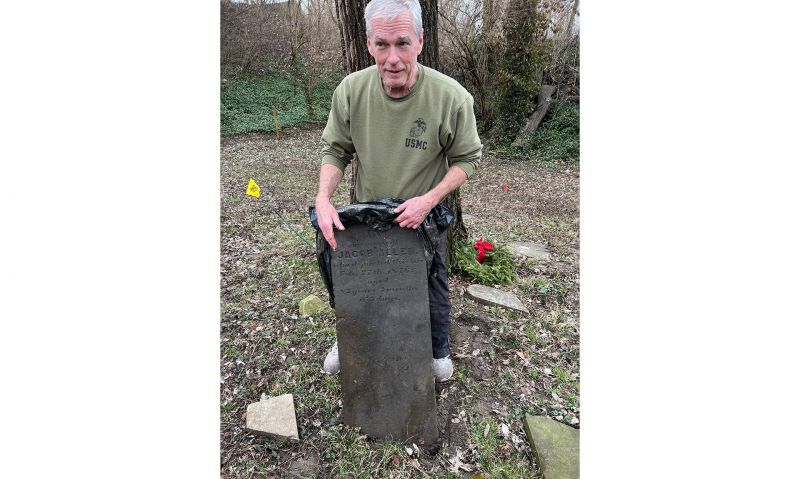
Cincinnati Legionnaires and high school students work to restore dilapidated cemetery, the final resting place of at least seven Revolutionary War veterans.
In February 2022, Hyde Park-Mount Lookout American Legion Post 744 (Cincinnati) member James Hay heard fellow Legionnaires talking about a cemetery in an industrial area of the city believed to be the burial place of Sgt. William Brown, one of just three recipients of the Badge of Military Merit that eventually became the Purple Heart. Brown received the honor from Gen. George Washington.
After finding Fulton-Presbyterian Cemetery, located off a bike path, he found no entrance and the area fenced off from the pathway. The only way to access the property was at the end of a small street and behind the back lot of a private business. To add to the difficulty, Google Maps misidentifies its location – the cemetery is at the end of Dumont Street, not Carrell.
Locating the abandoned property only marked the beginning of Hay’s efforts. There was heavy undergrowth and invasive species of plants that overran the entire cemetery, making it incredibly difficult to locate headstones.
“When I saw it, it just resonated with me,” said Hay, a Marine Corps veteran. “These guys gave up everything,” he continued, “Revolutionary War vets … and they’re found here in this armpit piece of land. It just resonated that we needed to do something about this.”
Rick Alrichs, a member of Mount Washington American Legion Post 484 in Cincinnati, agreed. “How could this cemetery be let go of?” he asked. “There are 80 to 90 souls there, especially vets, Revolutionary War vets. How do you abandon these guys?” the Army veteran added.
The next step for Hay was to find out who had rights to the property. He discovered that the cemetery was originally shared by the Fulton Church and the Columbia Presbyterian Church, in operation from the late 1700s to the late 1800s. Both churches no longer exist, and the Presbyterian Church headquarters in Cincinnati had ownership of the Presbyterian side of the property, with rights and responsibilities for the Fulton side from a court order in the 1960s.
“That’s when I called the Presbyterian church, and they were great to work with,” said Hay, who succeeded in getting transfer of the title to the lot, and assignment of rights and responsibilities, to Post 744. The church approved in August 2022, and the Hamilton County auditor completed the transfer in November 2022.
After getting the title, Hay said, “I knew it was going to be a multi-year project, and I didn’t know how we were going to pay for it.” Post 744 was unable to provide the financial support necessary to clean up and maintain the cemetery. Joel Belcher, a member of Squadron 484, wanted to help restore the cemetery, including fundraising. “Post 484 had money and wanted to support [Hay’s] passion,” Alrichs said. “[Hay] was doing it all on his own dime – getting equipment, paying for gas, paying the attorney to get control of the property, et cetera.”
In addition to Post 484’s direct financial support, Belcher is pursuing grants for the cemetery project. Southgate, Ky.’s VFW post also contributed to the cemetery restoration fund, and students in McNicholas High School’s Military History Club in Cincinnati have volunteered to help clean up the property and work to identify grave markers.
Hay praised the students’ hard work and noted that they came out to the property several times during the winter months, even when it was snowing. So far, they have discovered the headstones of at least seven Revolutionary War veterans who settled in the Columbia-Tusculum area of present-day Cincinnati after the war:
Jacob Allen
Pvt., Continental Line, Revolutionary War
1763-1846
Alexander Barr
1st Bn., Westmoreland County, PA Militia, Revolutionary War
1785
John Campbell
Continental Line, Revolutionary War
1750-1839
John Hammond
Continental Line, Revolutionary War
1753-1840
John W. Langdon
Continental Line, Revolutionary War
1759-1842
Hermanius Taulman
Continental Line, Revolutionary War
1731-1796
Robert Tolman
Continental Line, Revolutionary War
1794
“We’ve found what we believe to be about 80 different headstones so far,” Hay said, but added that they are often found in fragments, and it takes time to piece them together to do background research on the names and dates.
Hay said that he is in “phase 1” of the project, which is focused on “cleaning up and treating the land on the cemetery.” Although the Daughters of the American Revolution were the original caretakers of the veterans’ graves, the overall condition of the property is still badly dilapidated from over two centuries of wear and several decades of neglect.
Hay noted that the business’ owner has graciously allowed him and his volunteers to park on his property to enter the cemetery, but this is not a viable alternative for the public in the long term. Hay wants to “take down part of the fence and build a walkway off the bike path” near the site’s historical marker. He would also like to restore an original Daughters of the American Revolution archway, found on the property, and lay it in the ground by the public entrance.
The second phase will include searching for more headstones and restoring them, while the McNicholas students will start doing historical research on the veterans buried at the cemetery. While the actual grave of Brown has yet to be identified on the property, Hay said, “if it’s here, we’ll find it. I’m going to use an underground utility finder” in the second phase of the project to detect gravesites.
“No matter what it takes, [Hay] will get it done,” Alrichs added.
Jeffrey Layne Blevins is an Army veteran and professor in the Department of Journalism, and the School of Public and International Affairs, at the University of Cincinnati. He is a member of Post 484.
- Honor & Remembrance

